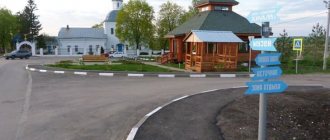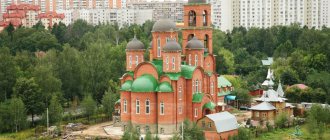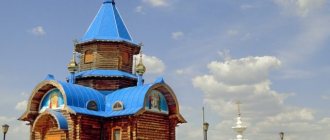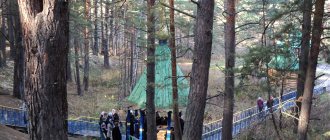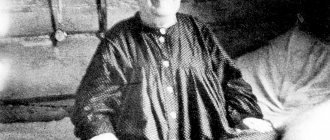In the south of the Moscow region, in a picturesque area near the city of Chekhov, there is an ancient monastery - the Ascension David's Monastery. 30 km from it is the village of Talezh, on the outskirts of which there is a spring of the same name. Every day these picturesque places are visited by many religious people interested in the development of Moscow lands.
Holy Spring of St. David in the village of Talezh
History of the village of Talezh and the Ascension Monastery
The first mention of Talezh dates back to 1328. The will of Prince Ivan Kalita mentions the “village of Talezhskoye”, which was inherited by his son Andrei. The settlement reached its heyday under Vladimir Grigorievich Orlov, to whom these lands were granted by Empress Catherine II. The Church of the Nativity of the Blessed Virgin Mary was built at the expense of the prince.
A significant contribution to the development of Talezh was made by the writer Anton Pavlovich Chekhov, who opened a school here. Today the village is known as the place where the Source of St. David is located in the village of Talezh.
Advice! After visiting the spring, it is worth visiting the restored Talezh temple - a beautiful architectural landmark, almost completely destroyed in Soviet times and restored at the beginning of the 21st century.
Also read:
- Source of Seraphim of Sarov in Diveevo
- Holy springs in Novosibirsk
- Holy places and sources of Russia
How does holy water help?
According to legend, Saint David of Serpukhov every day made walking trips from the monastery to the source (30 kilometers one way) in order to indulge in prayers alone.
The water absorbed sincere words and became crystal clear, acquiring the ability to heal ailments.
They note the unusual sweetness of the taste of this water and its softness. The uniqueness of the Talezh spring lies in the ability of holy water to heal diseases of the eyes and internal organs.
Talezh holy spring helps to cure:
- inflammation of the eyelids;
- conjunctivitis;
- lacrimation, eye fatigue.
Holy water from the Talezh spring:
- increases the percentage of vision;
- renews epithelial and integumentary tissues;
- has a beneficial effect on digestion and metabolism.
A pilgrimage to Talezh relieves stress, relieves depression, improves psychological and emotional mood, and improves immunity.
Important! Strong prayer for the health of our parents
After looking at a photo or video of the Talezh source, people often decide to visit the holy place. It is so far the only one in the Moscow region with a high level of comfort and organization.
Traditions of the Holy Spring
Many legends and stories are associated with the spring located in the ravine. According to one legend, he appeared from a ring with which Count Orlov tried to ask forgiveness from the girl he had offended. But she did not accept the expensive gift, threw it away and ran away, sobbing. And so, where the ring fell, a stream of water began to flow, clean and transparent as the girl’s tears. This beautiful story can often be heard from local residents.
Holy spring in Talezh
Another legend tells about events from the deep past. Since ancient times, a large oak tree grew in the ravine, revered by local residents who professed paganism. But then Christianity came to these lands and the inhabitants began to convert to the new faith. The subjects of the newly converted princes were not always happy about this event. An open religious conflict was brewing, but higher powers intervened. A thunderstorm broke out, lightning struck people's homes.
In the morning, the villagers went to their protector oak tree, but a strong spring flowed from the burnt remains of the giant tree. All residents were baptized in it. And the spring began to be considered holy.
Comments (13)
Anonymous
04.11.2012 at 12:16 |
wowwowReply
Tatiana (admin)
11/16/2012 at 10:19 pm |
Informative.

Reply
Sergey
05/26/2013 at 19:03 |
I visited the holy spring in Talezh several times. The source is beautifully landscaped and well maintained. There are always a lot of people.
Reply
Maksim
07/27/2014 at 20:15 |
I’ve been there twice already, the first time I got there by accident - I was driving with friends from the dacha and decided to stop and have a look, the second time I went on purpose, I was tormented by conjunctivitis. The water is truly healing. The source is open Tue - Sun, from 9-00 to 22-00, Monday is a sanitary day. Good luck
Reply
Vasily Belokurov
12/17/2014 at 5:16 pm |
Talezh is close in meaning to the word talets noted in V.I. Dahl’s dictionary - “live bait, key, spring.” Wonderful place! To visit there at any time of the year and in any weather means to receive a charge of vivacity and peace! Water of exceptional taste and quality! There is a belief that our army stopped there for the night before the Battle of Kulikovo... and this is ..1380 g...
Reply
Lana
07/14/2015 at 08:06 |
Tatyana, thank you for the information that was very necessary for me. I also decided to go to St. sources, but I don’t have any information. I typed it into the search box and your information was revealed to me. I'll go and write about my feelings.
Reply
Elena
01/31/2016 at 16:36 |
I've been swimming for 2 years now. We drink this water exclusively. I recommend. Tested for myself. The place is extraordinary.
Reply
Lena
09.20.2016 at 00:47 |
I was there on September 17, 16 in the evening, my loved one took me there. It was my first time, I went there - it was cold. After I drank water and washed my feet with this water, I felt warmer and so good that I didn’t want to leave. Now I want to come and take a plunge again. I hope I won’t freeze, I’ve never done this before. I'm drawn there.
Reply
Love
05.11.2016 at 20:59 |
Good evening! Please tell me how to get there on your own
Reply
Elena
05.11.2016 at 21:06 |
On the Salezh website it is written as.Talezh On public transport: from the Kyrgyz station by train to the Chekhov station. From the bus station, which is located next to the railway station, there is a minibus and bus No. 25. You need to get off at the “Talezh” stop.
Reply
Igor
02/01/2018 at 23:40 |
I wish everyone Health, Love and Prosperity. I was in this wonderful place. The atmosphere is simply wonderful. Words can't describe it. You just need to go there and you will understand everything yourself. I dipped into the font more than once. You leave there as if born again. I highly recommend visiting this Holy place. There are only positive emotions left.
Reply
Anna
02/17/2018 at 01:06 pm |
How far is it to walk from the stop? How often do the buses go
Reply
Anna
02/17/2018 at 13:05 |
Can you tell me if I go under my own power and walk far from the stop?
Reply
At the monastery courtyard
Today, the land near the miraculous spring and the Church of the Nativity of the Virgin Mary in Talezh belong to the courtyard of the Ascension David Hermitage.
The architectural ensemble surrounding the holy place includes:
- a chapel dedicated to the icon of the Mother of God “Life-Giving Spring”;
- Venerable David of Serpukhov;
- belfry;
- fonts for men and women;
- refectory;
- priest's dwelling.
The entire complex is surrounded by a wrought-iron fence with a single red brick gate. Their central part is decorated with the face of the Savior and a small dome with a cross. The main buildings are located in a low area, accessed by numerous wooden stairs with metal railings. All pedestrian paths and the banks of small streams, which originate from springs and unite into a river, are landscaped with stone.
Talezh. Source of St. David
The territory of the holy spring fits organically into the natural topography of the area in Talezh. Small temples and fonts do not stand out and do not dominate the natural environment. Lawns, plantings of trees and shrubs complement the natural beauty of the holy place.
Attention! It is forbidden to walk on the lawn or wash your feet in ponds on the shrine’s territory. It is also not allowed to throw coins into the waters of the spring and fonts. These rules are indicated on the relevant information plates.
Popular place of pilgrimage
The holy source Talezh is located in Chekhov.
Today it is a beautiful, landscaped place, located in a protected area, filled with the aromas of rare plants listed in the Red Book. In the 90s, the area was transferred to a monastery in David's Hermitage. In 1995, a chapel of extraordinary beauty, “Life-Giving Water,” the Church of David of Serpukhov was built and a cozy courtyard with an entrance gate was equipped.
Behind the temple there is a belfry with bells. A priest's house, men's and women's fonts were built.
This is interesting! Why does the Akathist to the Guardian Angel need to be read on Mondays?
Water is supplied to the pools through different channels. A pump room is equipped for collecting holy water in containers. All year round (even in severe frosts and summer heat) the temperature in the Talezh spring is stable, +4°C.
The surrounding forest is kept in proper order, so the ideal purity of the holy water is not threatened. A little below the courtyard, the Talezh spring turns into a stream, part of the bank of which is lined with stone tiles; even further it naturally flows between forest vegetation.
The natural softness and unusual taste of holy water from the Talezh spring are complemented by notes of various herbs. The bed of the legendary Smorodinka River has been filled with this living water for 6 centuries.
The path to the established Talezh spring goes down a long staircase. There is a wooden bridge with handrails across the stream. Pilgrims or casual visitors, tourists inevitably plunge into an atmosphere of positivity, joy, and spiritual bliss.
After bathing in the holy water of the Talezh spring, pilgrims acquire physical and spiritual strength.
Operating mode
You can visit the property of the monastery in Talezh from Tuesday to Sunday. On Monday, cleaning, repairs and landscaping work is taking place on the grounds and buildings.
On ordinary days, you can visit the holy place from 8 am to 9 pm. In the Church of the Nativity of the Blessed Virgin Mary, services are held on weekends and holidays. Baptism and wedding ceremonies are also held in the temple.
Important! The wedding ceremony is not performed on fasting days. Wedding processions are prohibited from entering the territory of the spring of St. David at this time.
How to get to Talezh
There are three ways to get to the Source of St. David, abbot of the Ascension, Serpukhov miracle worker, in the village of Talezh.
- The easiest way is to arrange an excursion trip with a travel agency. The program of most of them includes a visit to both the holy spring in Talezh and the monastery in the village of Novy Byt. Some tours also include a visit to the Chekhov estate in Melikhovo.
- Travelers who prefer to travel by public transport will have to take an electric train from Kursky Station to Chekhov, Serpukhov or Tula stations. Get off in Chekhov and go to the bus station located next to the railway station.
The journey will continue by minibus or bus following route No. 25 to the village of Talezh. You can complete the first part of the journey from Moscow by bus No. 365, departing to Chekhov from the Yuzhnaya metro station every half hour.
Holy Gate of St. David's Spring
For those who like comfortable travel in their own vehicles, you should follow the Simferopol Highway in a southerly direction. Following the road signs, turn towards the village of Melikhovo. Having passed it, move to a noticeable sign in the form of a small chapel.
Without entering the village of Talezh, you should turn left and move to a large parking lot adjacent to the territory of the holy spring.
Advice! A trip with children to the Chekhov district should include not only a visit to places of worship, but also to the estate of A.P. Chekhov in the village of Melikhovo. This will make the trip useful both for the spiritual development of the younger generation and for enriching knowledge about their native land.
Village Talezh Chekhovsky district
As you know, there are a lot of beautiful and significant places on the territory of our vast Motherland. One of them is the village of Talezh, which is located in the Chekhov district of the Moscow region. As you know, it belongs to the Barantsev community. The Smorodinka River also flows here, which is a tributary of the Lopasnya River. The nearest city of Chekhov is only 16 kilometers from the village, and the village is 56 kilometers from the Moscow Ring Road.
Name and history of its origin
In general, there is no definite theory about how the name of the village appeared. However, one of the popular assumptions is the presence of a large number of springs and springs in the village. And also the name “Talezh” is close to the word “talets”, which V.I. Dahl’s dictionary interprets as “spring, key or live bait”.
Population
If we talk about the local population, it is quite insignificant. Today, according to census data, more than thirty-five people live here. However, based on the indicators of past years, the population is slowly but confidently increasing.
Codes assigned to the village of Talezh, Chekhov district:
- tel. code: +7 49672
- index for sending and receiving letters: 142325
- OKATO: 46 256 804 003
- OKTMO: 46 656 404 256
History of the origin of the village
As you know, previously there was a continuous glacier on the territory of the entire Chekhov district, including the village of Talezh. As a result of the melting of this glacier, the Oka River was formed. Following it, the first settlements appeared on the right bank. The remains of Slavic villages that archaeologists discovered on the territory of Talezh are called “settlements.” However, they have reached our times in a severely damaged state.
Archaeological excavations
In the middle of the twentieth century, not far from the village, near the village of Zavalipyevo, archaeologists led by A.F. Dubinin carried out excavations. As a result of excavations, the Dyakovskoye settlement, which has the shape of a triangle, was discovered. By the way, it was located on a hill above the Lopasnya River, which is surrounded on all sides by ravines, and in the south by two large ramparts. So it helped the locals defend the village from attack.
During the research, we discovered some facts, for example:
- length of the settlement - 70 meters;
- width of the shafts - 30 meters;
- the layer of local culture was approximately 60 centimeters. This included ash, remains of living creatures, as well as handmade pottery;
- remains of bone production - various figurines, harpoons, and knife handles.
All these finds make it possible to reliably assert that life has been going on here since the beginning of the 8th century. BC and to the 6th century AD. This place was a patriarchal clan settlement, which had good defenses. By the way, all these attractions still exist today.
A little later, in 1971, during work on the river bank, they found a workshop where tools were made from silicon, namely:
- axes;
- spears;
- knives.
According to archaeologists, these finds were created during the Neolithic period.
Nearby is Prince's Meadow, which was created during the reign of Yaroslav the Wise. By the way, he is mentioned in “The Tale of Igor’s Campaign.”
The village was first mentioned in 1328.
As you know, in 1646 there were 15 households on this land, and in 1674-1677 there were 19 households with peasants.
It is also worth noting that in 1768, fifty men and fifty-one women lived here.
However, life for the local population was not the best. The peasants themselves spoke about this in 1737. Although they worked hard, they were paid very little, and almost everything went to taxes. However, even during this difficult period there were peasants who began to struggle out of their impoverished life. They were called “living”. For example, they were often engaged in the resale of bread, wool and meat. By the way, the first living family were the Ignatovs. At its head was Yevsey. Because they worked so hard, they were not sent to corvee labor.
In the middle of the 18th century, as is known, the government changed. As a result, Vladimir Grigorievich Orlov began to rule in Talezh.
Since the locals were Old Believers, Count Orlov demanded that they accept the Orthodox faith. And if they did not comply, he threatened to sell them. As a result, after three warnings, they were sold to Moscow.
Church of the Nativity of the Blessed Virgin Mary
At the end of the 18th century, the Church of the Nativity of the Blessed Virgin Mary was erected on the outskirts of a high ravine. The construction was paid for by Count Vladimir Grigorievich Orlov. The construction team was headed by Ivan Babkin, who was completely guided by the project of the architect Nazarov from Moscow.
The temple consisted of:
- white brick building;
- metal fence;
- Bell tower;
- 4 pylons;
- hemispherical dome with a branched cross;
- the façade of the temple is covered with rustication;
- paired pilasters separate the drum, the walls of which go to the ground itself and form the central part of the temple.
This temple was erected in memory of the church destroyed in 1794, which was located in a neighboring village. Most of the icons in the Church of the Nativity of the Virgin are from the dismantled church.
Count Orlov paid not only for the construction, but also for the purchase of everything necessary. It was Vladimir Grigorievich who donated the cross, which became the reason for a large gathering of people on Remembrance Day, when Rus' was baptized.
Many years later, in 1846, the temple in Talezh, Chekhov district, was reconstructed into one large dome instead of five spiers.
This day was the final day of construction. To this day, the church has not changed.
The inside of the church was painted in 1871. Most icons have been updated.
In 1882, Abbot P.V. Velichkin wrote a manuscript, which to this day has not been published. It told about the initial construction of the temple in Talezh.
It was this abbot that Anton Pavlovich Chekhov knew, whom they met at a local school in the village of Talezh.
In 1885, Velichkin replaced the wooden bars on the windows with metal ones. And in 1927, despite difficult times, they wanted to restore the temple.
It operated until 1939, after which there was a lull, and until June 19, 2011 the temple did not work.
In addition to all of the above, the village of Talezh is famous for its holy spring, endowed with healing properties. Pilgrims can visit the Talezh spring from 8:00 to 21:00.
In addition, there is a church shop and a tea house (next to the source) in the village of Talezh opening hours: in summer - on weekdays from 9:00 to 19:00, on weekends from 9:00 to 20:00, in winter - from 9:00 to 19:00 18:00 on weekdays, from 9:00 to 19:00 on weekends and holidays.
You can read more about it here.
The village of Talezh how to get there and by what?
There are three ways to get to the village of Talezh, namely:
- By car on the Crimean highway M2, you should turn left at 72 kilometers, after driving 11 kilometers to Melikhovo, you need to turn left at the sign “Talezh”.
- by bus 428, which travels from Chekhov to Moscow, via Nerastnoye.
- by train to Chekhov station, after which you need to take bus 25, which will take you to the Chaika or Talezh stop. By the way, the train schedule can be found at the station.
